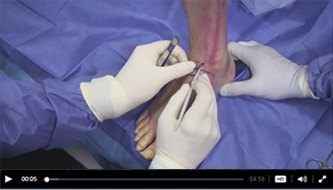Osteochondral Lesions
The ankle joint is an articulation of the end of the tibia and fibula (shin bones) with the talus (heel bone). Osteochondral injuries,also called osteochondritis dissecans, are injuries to the talus bone, characterized by damage to the bone as well as the cartilage covering it. Sometimes the lower end of the tibia or shin bone may also be affected.

Causes
Osteochondral injuries are most often caused by trauma to the ankle joint, such as with ankle sprains. Some cases may not have any previous history of ankle injury, and may be caused by local osteonecrosis or a metabolic defect.
Symptoms
The predominant symptom of osteochondral injury is pain, which may be localized to the ankle joint. Other symptoms may include tenderness and swelling of the ankle joint with difficulty in weight bearing, locking of the ankle or instability.
Diagnosis
Osteochondral injuries are diagnosed by physical examination, X-ray and CT and MRI scans. Plain X-ray images can reveal other fractures, bone spurs and narrowing of the joint. A CT scan helps identify any bony fragments and cysts, but is not very helpful to visualize bone edema or cartilage defects. MRI is the best imaging modality, which helps to visualize the cartilage and bone lesions as well as bone edema.
Treatment
Non-surgical or surgical treatment may be recommended for the management of osteochondral injuries of the ankle joint. Non-surgical treatment with immobilization, restricted weight-bearing and physical therapy may be ordered to help the bone and cartilage to heal, and improve muscle strength, mobility and coordination. Surgical treatment is recommended for more severe injuries and comprises of debridement (removing) of the damaged cartilage and removal of any loose bodies. Some of the most commonly used surgical techniques include microfracture or drilling of the lesion, grafting of cartilage and bone, or fixation of the fragments with the help of screws.











